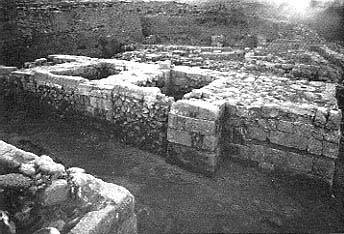Image Details

Oriental Institute, University of Chicago
Beam recesses in the Megiddo gate. Israeli archaeologist David Ussishkin contends that the lowest courses of this wall, including the recess between the second and third courses, were the foundation of a gate built by King Ahab in the 9th century B.C. Archaeologist Yigael Yadin believes that this wall is part of the gateway built by Solomon in the 10th century. Author Valerie Fargo agrees with Yadin and points to this photograph from the original excavation archive as evidence.
Taken in 1936, this photograph preserves the image of a recessed earth and pebble layer running between the second and third courses of the wall. This recess probably held decorative wooden beams. If Ussishkin were correct that the lowest courses were the foundation of a gate built by Ahab in the 9th century B.C., these decorative wooden beams could not have been seen. However, the builders would not have built the wall with decorative wooden beams that could not be seen. Author Fargo argues that this use of decorative beams demonstrates that the first four courses were not foundation courses, but rather part of the exposed gate built by King Solomon in the 10th century.
